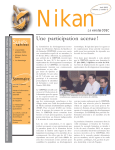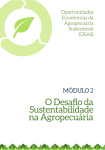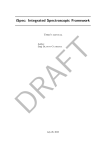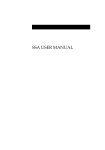Download USER'S MANUAL
Transcript
USER’S MANUAL SUSTAINABLE DEVELOPMENT ANALYTICAL GRID FOR COMMUNITY-BASED PLANNING AND TERRITORIAL MANAGEMENT Version 2 December 2005 USER’S MANUAL FOREWORD The conception of a sustainable development analytical grid for communitybased planning and territorial management is the product of collaboration between the First Nations of Quebec and Labrador sustainable Development Institute (FNQLSDI) and the Department of Indian Affairs and Northern Canada (DIAND), Quebec Region, in a shared will of offering support to First Nations communities and facilitate reflection on sustainable development. The following document presents an analytical grid for the purpose of community-based planning and territorial development that emphasizes the importance of indicators and also refers to the various existing measurement tools and to the previously established First Nations of Quebec and Labrador Sustainable Development Strategy. However, this document is not an exhaustive literary review of sustainable development related tools, measurement and theories. It is mainly intended as a manual that aims at clarifying the rationale and potential use of the grid; it is an exploratory approach that allows a better identification of communities’ needs and opportunities. The statements made in this document as well as the indicators suggested in the grid are meant to be discussed, modified and adapted to communities’ specific needs as well as to their existing strategies. 1 First Nations of Quebec and Labrador Sustainable Development Institute USER’S MANUAL INDEX FOREWORD p. 1 INTRODUCTION p. 4 SECTION I. Need for measurement p. 5 SECTION II. Selection of indicators of the sustainable development Analytical grid for community-based planning and territorial management 2.1 Department of Indian Affairs and Northern Canada (DIAND), Quebec Region 2.2 p. 7 First Nations of Quebec and Labrador Sustainable Development Institute (FNQLSDI) 2.3 p. 6 p. 8 Coherence in the collaboration between the FNQLSDI and the DIAND, Quebec Region p. 10 SECTION III. Presentation of the sustainable development analytical tool p. 11 3.1 Goal and usefulness p. 11 3.2 Use p. 12 3.3 Conditions for success p. 13 2 First Nations of Quebec and Labrador Sustainable Development Institute USER’S MANUAL SECTION IV. Sustainable development analytical grid 4.1 p. 14 Steps to follow to use the sustainable development analytical grid p. 14 4.2 State and response indicators p. 15 4.3 Performance assessments p. 16 4.4 Grey boxes and yellow boxes p. 18 4.5 External factors beyond (the community’s) control p. 19 4.6 Limits and advantages of the tool p. 19 CONCLUSION ANNEX I - p. 21 Matrix of the sustainable development analytical grid for community-based planning and territorial management p. 22 ANNEX II - Sustainable development analytical grid additional information index card p. 23 3 First Nations of Quebec and Labrador Sustainable Development Institute USER’S MANUAL INTRODUCTION Several reasons justify measuring the progress First Nations communities have achieved with regard to sustainable development. Let us note that the widespread will to protect the territory and the environment, to use natural, human and social resources efficiently and equitably as well as the concrete accountability duty towards First Nations members are as many dictates that compel the drawing up of an accurate portrait of the situation. Moreover, First Nations stated will to participate in the process of society building by enhancing the efficiency of governmental activities and by fostering meaningful and productive partnerships constitute additional motives leading to the relevance of thinking through the goals of development projects having an impact on First Nations communities. These justifications emphasize the real need for measurement tools, especially for those who help promote the facets of sustainable development as a whole. The proposed grid tries to align currently available sustainable development tools with the priorities set out in the First Nations of Quebec and Labrador Sustainable Development Strategy1. A number of indicators have been identified as representative of such concerns. However, they are only intended as proposals whose purpose is to bring forward the debate on the long-term aspirations and issues of the communities and their members. The Analytical Grid for Community-Based Planning and Territorial Management along with its user’s manual will enable to analyze a community in the light of sustainable development indicators and implement modifications if need be. We hope that after having used this tool you can integrate the principles of sustainable development within your communities. We also hope you will 1 Secretariat of the Assembly of First Nations of Quebec and Labrador, “Sustainable Development Strategy for the First Nations of Quebec and Labrador”, Assembly of First Nations of Quebec and Labrador (AFNQL), November 1997. 4 First Nations of Quebec and Labrador Sustainable Development Institute USER’S MANUAL become increasingly aware of sustainable development and that you will be able to reflect upon the conditions that will ensure the success of a project. SECTION I. Need for measurement Target objective of this section -Grasp the added value of a measurement tool Measurement facilitates the process of integrating abstract ideas about sustainable development into the actual operations and activities of First Nations communities and institutions. Indeed, indicators help leaders and stakeholders identify various objectives and certain targets, as well as assess progress made and the effectiveness of interventions carried out. Measurement supports policy directions and realigns them according to the changes occurring in problem situations. It constitutes an empirical basis for assessing performance and making comparisons over time and place. Thus, in a sustainable development perspective, measurement provides the basis for laying out future actions. To establish your communities’ profile, decision-makers need tools that allow them to establish the relationships between past and present day activities and future goals. Indicator systems figure among these indispensable tools. In short, measurement is especially useful since it makes it possible to2: ► understand the meaning of sustainable development in terms of operations (here, measurement and indicators are explanatory tools that translate ideas associated with sustainable development into concrete, tangible components; by setting forth transparency as a value, indicators facilitate communication and sharing of values specific to sustainable development. They are also powerful 2 HARDI, P., BARG, S., HODGE, T., PINTER, L., Measuring Sustainable Development A Review of Current Practice, Occasional Paper Number 17, International Institute for Sustainable Development, Industry Canada, Canada, 1997, p.7. 5 First Nations of Quebec and Labrador Sustainable Development Institute USER’S MANUAL motivating and communication tools because they allow people to observe and compare results achieved with desired results.. ► opt for sustainable development supporting policies (measurement and indicators forge links between daily activities and sustainable development; indicators serve to orient the thinking of decision-makers who must choose among many policies: they then have planning tools. ► assess the success of efforts made towards reaching sustainable development goals and objectives (in this case, measurement and indicators are performance assessment tools; they allow sectors requiring immediate intervention to be singled out for attention, they also help to bring certain substantive questions to light, to locate information needed for performance reporting and to draw a true picture of the situation on the basis of a broad range of information). SECTION II. Selection of indicators for the sustainable analytical grid for community-based planning and territorial management Target objective of this section: - Determine what nourishes a holistic reflection on sustainable development Introduce the visions of the First Nations of Quebec and Labrador Sustainable Development Institute and of the DIAND, Quebec Region The sustainable development analytical grid for community-based planning and territorial management is mainly based on certain existing analyses: mainly the one of the First Nations of Quebec and Labrador Sustainable Development 6 First Nations of Quebec and Labrador Sustainable Development Institute USER’S MANUAL Institute as well as of those of the Canadian federal government and other international bodies such as the United Nations (UNCSD) and the World Trade Organization (WTO). Most of these analyses are based on Action 21, the action plan recommended at the 1992 Rio de Janeiro Summit, which calls upon countries, international bodies and non-governmental organizations to develop and use sustainable development indicators. 2.1- Department of Indian Affairs and Northern Canada (DIAND) In an outgrowth of the amendments made to the Auditor General Act, the DIAND was compelled by law to write a sustainable development strategy for filing prior to 1997. For the federal government, any such strategy must be devised jointly with the main partners; thus the consultation among the Assembly of First Nations of Quebec and Labrador (AFNQL). The Quebec Region unit thus chartered its strategy for 2004-2006 and chose objectives related to the following five broad themes: • Consultation and joint decision-making Develop a consistent approach to consultation with First Nations and Inuit. Develop regional co-operative processes among federal departments and Aboriginal communities and organizations to discuss common priorities. • Long-term planning Establish an integrated community-based planning framework applicable on the federal scale. Foster the development of community-based sustainability frameworks to ensure the community’s viability and measure and assess its well-being. 7 First Nations of Quebec and Labrador Sustainable Development Institute USER’S MANUAL • Water management Adopt a safe and secure water supply and effective wastewater treatment strategy for all First Nations communities. • Climate change and energy management Develop a long-term strategy to assist Northern Aboriginal communities to adapt to the impacts of climate change. • Integration of sustainable development into departmental policies and processes Develop effective tools and procedures to integrate sustainable development into departmental processes. Raise awareness and effectively communicate the concept of sustainable development and the Department’s Sustainable Development Strategy. Modify organizational structures and accountability and clarify stakeholders’ roles to effectively integrate sustainable development into departmental processes. Establish environmentally operations. sound management of DIAND The Department has planned various activities to implement its strategy and achieve its objectives – tools development in particular – and thereby be in a position to actualize its sustainable development commitments. 2.2- First Nations of Quebec and Labrador Sustainable Development Institute (FNQLSDI) In 1997, the Assembly of First Nations of Quebec and Labrador seized the opportunity offered by the federal government’s initiative to develop its own strategy entitled The First Nations of Quebec and Labrador Sustainable Development Strategy. This decision was confirmed by its political authority, the 8 First Nations of Quebec and Labrador Sustainable Development Institute USER’S MANUAL Chiefs’ Assembly, who viewed the concepts and foundations of sustainable development as being in large measure modelled after the First Nations way of life. The First Nations of Quebec and Labrador Sustainable Development Institute was set up for the purpose of implementing the sustainable development strategy that had been developed by a working group under the control of the Assembly of First Nations of Quebec and Labrador. Since then, the Institute has taken an active role in several sustainable development matters of concern to the First Nations of Quebec and Labrador communities, particularly natural resources, the environment, respect for the specificity of the First Nations traditions and cultures, and community-based planning and territorial management. Specifically, this strategy is organized into seven strategic objectives: 1. Cultures and languages 2. Quality of territory and resource sustainability 3. Social development 4. Economic development 5. Need for partnership 6. Participation in the decision-making process 7. Implementation of sustainable development The Institute’s mission is to support each First Nation’s efforts to implement the First Nations of Quebec and Labrador’s Sustainable Development Strategy3. The Institute is responsible for identifying and developing methods enabling the definition of traditional values and principles having potential relevance to the modern concept of sustainable development framing the current and future policies governing the use of traditional lands, with a view to ensuring 3 New version of the Sustainable development strategy available on spring 2006 9 First Nations of Quebec and Labrador Sustainable Development Institute USER’S MANUAL quality of life while respecting resource sustainability. Such a perspective or approach would serve to improve land evaluations well before the creation of any land use plans respecting resource utilization. The Institute acts as “technical resource person” for the Quebec and Labrador Chiefs and communities, especially by providing them with the “tools” required to pursue and attain their goals. 2.3- Coherence in the collaboration between the FNQLSDI and the DIAND, Quebec Region. The Institute has given itself the goal of helping First Nations acquire the tools required to implement the Sustainable Development Strategy – and important resource in Aboriginal community capacity-building, community-based planning, and all sustainable development-related matters. At the same time, the Quebec Region unit of the Department has set itself the objective of supporting the First Nations in defining their vision of development and in using community-based planning and territorial management as a development tool. This objective and its main activity aptly capture the spirit underlying the Department’s commitment to the present project of working up an analytical grid for community-based planning and territorial management. Toward this end, it foresees working in close collaboration with the Sustainable Development Institute in order to acquire the required tools and to develop an integrated comprehensive community-based planning approach. Collaborating with the Institute is essential for producing such a tool, which will help communities analyze their situation and obtain a performance profile as the result of using the proposed sustainable development indicators and of taking stock of their intervention strategy. 10 First Nations of Quebec and Labrador Sustainable Development Institute USER’S MANUAL In this connection, the Atlantic region experience stands out as a point of reference4 and the First Nations community planning model developed and experimented by the Atlantic actors is now becoming the national benchmark for community-based planning. This eight-phase model describes an ideal community-based planning process consisting of: Phase 1: Gathering background information Phase 2: Identifying strengths and issues Phase 3: Searching for connections Phase 4: Establishing a «Vision» Phase 5: Building the framework Phase 6: Developing projects Phase 7: Implementing projects Phase 8: Monitoring The proposed analytical grid fits in with the second phase of this process, but it can also be used by all communities wishing to assess the box score of a situation. SECTION III- Presentation of the sustainable development analysis tool 3.1- Goal and usefulness The sustainable development analytical grid for community-based planning and territorial management is intended as a measurement tool to help foster communities’ sustainable development. It is used, among other things, to 4 PALERMO Frank (dir.), “First Nations Community Planning Model,” 1st edition, Cities & Environment Unit, 2000, pp.10-11. 11 First Nations of Quebec and Labrador Sustainable Development Institute USER’S MANUAL diagnose communities’ vision of sustainable development by setting sustainable development objectives. The tool thus enables its user to take a step back and take stock of the community’s concerns and objectives and better assess the link between its directions and the sustainable development of the community.. It can also pool together the various actors in the community. It will then allow reasserting the basic objectives and identifying the directions that will enable achieving sustainable development. It thus facilitates the emergence of a shared understanding within the community. 3.2- Uses The sustainable development analysis grid can be used at several stages of the design of a community-based development plan. It is especially effective at the very beginning of the process where it can be used as a guide for the elaboration of a community-based development plan. Even before the elaboration of a community-based development plan, the tool can be used to guide the consultation of the community. Indeed, the analytical grid is designed to help reflect on the concerns of the community. Afterwards, the information gathered among the members can thus be used to determine the sustainable development objectives relevant to the community. Integrated at the very beginning of the elaboration of a development plan, the analytical grid will be able to guide users during its implementation. Thanks to this tool, they will be able to constantly reassess the projects with sustainable development objectives and, if need be, introduce new measures. 12 First Nations of Quebec and Labrador Sustainable Development Institute USER’S MANUAL 3.3- Conditions for success Consultations held on the Atlantic model of community-based planning have been instrumental in pinpointing the key conditions for the success of such initiatives and of sustainable development. According to theses experiences, it is probable that development efforts are more likely to be successful in a community that takes the following actions: • Share a common vision with its environment The first step a community must take regarding its development is to create and share a vision with all its members. Establishing a common vision highlights the values that are important to the community and allows its members to express their vision of an ideal future. This vision helps to define the type of development the community wishes for to ensure the quality of life of all its members. • Have the will to be in charge of the situation The development of a community will be much more efficient if the motivation to bring about positive changes comes from the members of the community rather than from outside said community. This motivation will be present if the members are made aware of the fact that outside professionals and specialists are not the only ones that hold all the solutions to their development. They also have an expertise with regard to their community. • Define a development plan and indicators Community-based planning is a process that helps the members of a community determines their needs, aspirations and knowledge. Before initiating any action, it is important to establish the diagnosis 13 First Nations of Quebec and Labrador Sustainable Development Institute USER’S MANUAL of the community by identifying its capacities, weaknesses and possibilities as well as the challenges it must face. During the implementation of a development plan, the follow-up of the activities will also be an important success factor. This can mean that the groups and persons involved will have to demonstrate flexibility and adaptability with regard to problem solving and carrying out tasks during the whole process. Finally, a good plan also means that success indicators have been identified at the very beginning of the design of the communitybased planning project. The data gathered on these indicators will enable to readily assess goal achievement. SECTION IV- Sustainable development analytical grid Target objective of this section: - 4.1 Facilitate the use of the sustainable development analytical grid for community-based planning and territorial management Procedures related to the use of the sustainable development analytical grid The sustainable development analytical grid for community-based planning and territorial management is a computerized tool that enables Aboriginal communities to draw a portrait of their situation for a given period. This tool is made up of sustainable development status indicators divided into four (4) categories: - Government, the financial situation, administration of justice and participation in the decision-making process / Civic commitment; 14 First Nations of Quebec and Labrador Sustainable Development Institute USER’S MANUAL - Social development, education, health, language and culture; - Economy, employment and infrastructures ; - Territory, resources and environment. The sustainable development analytical grid enables communities to draw a portrait of their situation for a specific period and ensure that all sustainable development aspects and objectives are taken into consideration during the elaboration of a community-based development plan. Thus, sustainable development indicators enable to determine to what degree the various objectives and concerns of the communities are applicable, while the performance of the sustainable development indicators indicates to what performance level each indicator is deemed pertinent. To assess these indicators, a pre-established performance yardstick is earmarked to each sustainable development indicator. The sustainable development grid uses the concepts of state forces, response forces and driving force developed by the United Nations. The analytical grid proposes status indicators and response indicators whose performance can be assessed by assigning a rating from 0 to 5 according to their performance values. 4.2 Status and response indicators Status indicators are a reflection of condition and status of sustainable development; response indicators are a reflection of the strategies implemented or to be implemented by the community as well as the changes that have or will have an impact on a given problem so as to improve the situation with relation to the ideal target situation. 15 First Nations of Quebec and Labrador Sustainable Development Institute USER’S MANUAL It is sometimes difficult to determine if an indicator is a status indicator or a response indicator. For example : It should be noted that over time, categories of indicators can evolve differently depending on the communities involved and end up in another category than the one it was placed in originally. Thus, a response indicator, such as use of community-based planning could at some point become a status indicator inasmuch as the response has been established. In this case, the status indicator would then reflect the community’s progress in sustainable development and the response indicators could consist in the mechanisms to be put into place to promote or garner community support. Communities may adapt the sustainable development analytical grid to suit their reality and indicate their own specific response strategies as well as external factors beyond their control that may have a potential impact on a given indicator in the optional additional index cards (annex II). The objectives of the First Nations of Quebec and Labrador Sustainable Development Strategy pursued through the measure are present in order the specify the relevance of the proposed indicator. 4.3 Performance assessments For each of the proposed indicators, the performance of the status and response indicators may be evaluated between 0 and 5 (1 being the lowest rating and 5 the ideal performance). 16 First Nations of Quebec and Labrador Sustainable Development Institute USER’S MANUAL PERFORMANCE YARDSTICK Empty box: The indicator does not apply in the context of the community. 0: The indicator is applicable in the context of the community and no action has been taken. 1: Performance is at its lowest and there is no reason to think that it will improve in the short run. 2: Performance is at a low level, but improvement is conceivable in the long run taking the current context into account. 3: Performance is average, satisfactory. 4: Performance is very or quite satisfactory and significant progress is conceivable in the short or medium run taking the current context into account. 5: Performance is ideal. For each of the status indicators in each of the sustainable development concerns and objectives identified in the sustainable development analytical grid, we must ask the following question: “Is the sustainable development indicator applicable in the context of our community? If so, what is its level of performance? “ Thus, for each of the response indicators in each of the sustainable development concerns and objectives identified in the sustainable development analytical grid we must ask the following question “What is our response strategy to this sustainable development indicator? And what is its level of performance?” 17 First Nations of Quebec and Labrador Sustainable Development Institute USER’S MANUAL The user answers on his own or within a team effort by rating (between 0 and 5) each proposed sustainable development indicator in the sustainable development analytical grid according to the performance yardstick. 4.4 Grey boxes and yellow boxes It should be specified that the indicators in the grey and yellow boxes require more attention when their performance is assessed for the grey boxes will have a performance score inversely proportional to the rating assigned to it. Grey box example: Thus, a very high unemployment rate in a community does not correspond to a very high performance rating (rating 5). On the contrary, this kind of result corresponds to a low rating (rating 5). As for the yellow boxes, performance score will be either inversely proportional either normal, depending on the interpretation you will give it. Negative interpretation example: Thus, a negative interpretation would be that the rate of diabetes in the community is high, thus the performance score will be inversely proportional to the rating assigned to it. Positive interpretation example : On the other hand, a positive interpretation of the indicator would be that in spite of the fact that the rate of diabetes is high in the community, taking into consideration the fact that the cases of diabetes have all been diagnosed will 18 First Nations of Quebec and Labrador Sustainable Development Institute USER’S MANUAL result in the opposite of a negative interpretation of the indicator, that is a normal performance score according to the performance yardstick. 4.5 External factors beyond (the community’s) control In this framework, external factors beyond control that may have potential repercussions on the indicator refer to the many exterior situations communities experience and that can explain a status or partial response to a problem that is not the full responsibility of the community or that creates some kind of pressure. For example, if a negotiation with a timber company is in progress, the score performance of the indicator of « Proportion of managed selected forest » could be influenced by said negotiation as long as no agreement is reached. Thus, the external factor beyond control explaining the score performance reached would be the negotiation for an agreement with timber company. You must then post state and response indicators affected by the external factor in the section earmarked for this purpose at the end of each of the categories. This will enable to identify and explain the external factor out of the community’s control that exerts a temporary impact on the performance result of the indicator. 4.6 Limitations and advantages of the tool The main purpose of the sustainable development analytical grid on communitybased planning and territorial management is to draw an accurate picture of the situation of a given community for a specific period in order to ensure that all 19 First Nations of Quebec and Labrador Sustainable Development Institute USER’S MANUAL aspects and objectives of sustainable development are taken into account. Thus, certain tasks cannot be completed by using this tool. It is important to understand that the analytical grid does not give totally objective answers with regard to the quality of the indicators of sustainable development. Consequently, it is advisable to use it within a team. Members of a team complement each other thus allowing for a deeper reflection on sustainable development leading to a more comprehensive vision and a better assessment of the community’s strengths and weaknesses. The organization of the sustainable development analytical grid and the selection of indicators is a choice that inevitably simplifies the complexity of reality, the interdependence of the various factors for a given problem and the chains of causation between the various sectors. It is the very nature of any grid, of any theoretical model. Moreover, the indicators currently proposed give disproportionate importance to the environment sector compared to all the other sectors: social, education, health, language and culture, economy, employment, infrastructures, territory, government, the financial situation, justice administration, participation in decision-making and civic commitment. It would be advisable to choose priority fields in the environment sectors and propose certain relevant indicators in the fields that are under-represented. The grouping of indicators on the basis of the big axes accounts for the frameworks adopted by both the First Nations of Quebec and Labrador Sustainable Development Institute and the DIAND, Quebec Region, while respecting widely recognized sustainable development terms (environment, economy, society and institutions). Moreover, the tool, represented in matrix form is simple, easy to manipulate and allows for a holistic vision of the situation while presenting detailed information on he community. Another definite advantage of the tool lies with its flexibility and the possibility it offers users to integrate their comments and response strategies specific to their community. 20 First Nations of Quebec and Labrador Sustainable Development Institute USER’S MANUAL CONCLUSION Given the great number of possible scenarios, it is important to keep in mind that this sustainable development analytical grid proposes nothing more than a snapshot of a given situation, which could certainly supply food for thought, debates and discussions on the community’s directions. We thus propose, as a first phase of community-based development, a qualitative self-evaluation conducted by the persons in charge of programs in the communities instead of a performance conversion grid based on accurate quantitative measurements, since such information is much more difficult to gather. However, undoubtedly, inasmuch as certain information exists, it can nourish the reflection on and support of the assessment of indicator performance. In short, the proposed tool allows communities to adjust it to their specific situation. The sustainable development analytical grid for community-based planning and territorial management is an adaptable tool designed to help communities draw up their profile, which is an essential step towards producing a clear definition of their vision and long term objectives for achieving autonomy and succeeding in developing a community-based development plan. 21 First Nations of Quebec and Labrador Sustainable Development Institute USER’S MANUAL ANNEXE I - Matrix Performance scores for each category represent the grand mean of each section that are posted in the matrix. This diagram enables to show the general performance scores of each community and visualize their strengths and weaknesses according to the big sectors of sustainable development. 22 First Nations of Quebec and Labrador Sustainable Development Institute USER’S MANUAL ANNEX II Additional information index card for the sustainable development analytical grid. Index card no.: Name of the community: Sector of activity: Resource persons: Category: Status indicators: Comments and/or response strategies. 23 First Nations of Quebec and Labrador Sustainable Development Institute

































